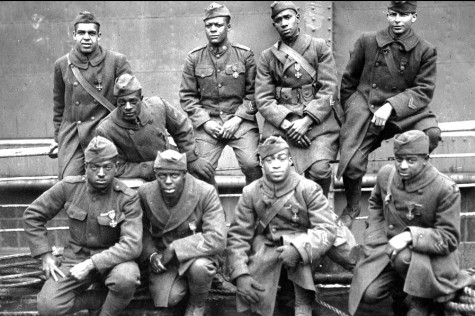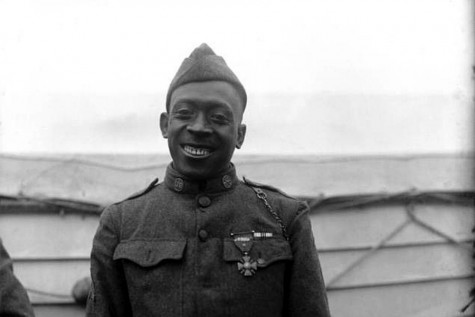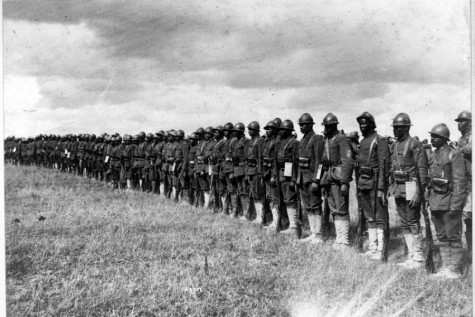The 369th fought against Germans, for the rights of black American soldiers

Soldiers of the 369th (15th N.Y.) who won the Croix de Guerre for gallantry in action, 1919. Front row: Pvt. Ed Williams (left), Herbert Taylor, Pvt. Leon Fraitor, Pvt. Ralph Hawkins. Back Row: Sgt. H. D. Prinas, Sgt. Dan Storms, Pvt. Joe Williams, Pvt. Alfred Hanley, and Cpl. T. W. Taylor.
During the First World War, the 369th Infantry Regiment, made up of black soldiers and officers, served with the American Expeditionary Force on the Western Front.
However, the regiment was forced to fight not only Germans in the trenches, but racial discrimination in the U.S. Army and at home.
The 369th was first formed as the 15th New York National Guard Regiment in 1913 and, in 1916, reformed under the designation of the 369th.
In April 1917, the United States entered World War I against the German Empire and began sending troops overseas to France to fight in the trenches.
However, most black Americans who joined the Army did not see combat. White politicians and generals sent black Americans to labor battalions, keeping them far behind the front lines to handle tasks that were thought to be “degrading” for white soldiers.
The labor battalions were forced to tackle the tasks of clearing battlefield debris, exhuming the bodies of fallen soldiers, and hauling the bodies to cemeteries.
The 369th also suffered from intense racial discrimination by white troops who refused to fight alongside black units.
However, to the relief of the soldiers of the 369th, the U.S. Army offered them to the French army to use in combat. The French army, desperately in need of men, accepted them.
To the surprise of the men of the 369th, the French did not racially segregate them from white units. French troops did not show hatred toward them, letting black Americans feel what it was like to be treated equally.
The French army supplied the regiment with French rifles and helmets, while keeping the men in American uniforms.
The 369th first saw combat in May 1918 and served in the trenches against German troops until July 3, 1918.
After a brief period of relief, the 369th was put back into combat during the Second Battle of the Marne.
While fighting in the trenches, German propaganda pamphlets were dropped on the 369th, asking why black Americans fight for people that discriminate against them, tempting them to join the German war effort.
Not one man of the 369th took up the German offer to surrender.

Sgt. Henry Johnson of the 369th
In addition, numerous soldiers in the regiment were awarded medals for valor.
German soldiers, shocked by the ferocity and heroism of the black Americans, gave them the nickname the “Harlem Hellfighters.”
The name stuck, and the 369th carried the title with pride.
In May 1918, while on guard duty, Sgt. Henry Johnson fought off a German patrol using grenades, his rifle, and a bolo knife.
“I banged them on the dome and the side and everywhere I could land until the butt of my rifle busted,” Johnson said in “History of the American Negro in the Great World War.”
“I stuck one guy in the stomach and he yelled in good New York talk: ‘That black ____ got me.'”
By the end of the war, 171 soldiers of the 369th were awarded the Legion of Honour or the Croix de Guerre.
Johnson was also awarded the Croix de Guerre, and he died in 1929. He later was posthumously awarded the Medal of Honor by President Barack Obama in 2015.
The entire regiment was eventually bestowed with a regimental Croix de Guerre for their service with the French army.
The 369th ended World War I in the Vosges Mountains on Nov. 11, 1918, when the Armistice went into effect at 11 a.m.
The regiment, having earned numerous unit and individual citations for valor, became the first New York regiment to return back to the states and was highly regarded by both black and white Americans back home, a feat never accomplished before by a black unit.
The 369th broke down racial boundaries, proving that black soldiers were not inferior to white soldiers in any way and could fight with just as much vigor and courage as their white counterparts.
The 369th eventually paved the way for desegregation of the United States military after World War II, giving black men the chance to serve their country in combat alongside other Americans.

The 369th stand at attention in France.
Without the successes of the 369th Infantry Regiment, equal rights for black soldiers, and perhaps black Americans as a whole, might have taken longer to achieve.
The 369th showed America that black Americans could fight and were proud to fight for a country that resented their presence.
As Black History Month comes to a close, the efforts made by blacks — the 369th Regiment included — in the fight for civil rights should be thought about, along with how much the world has changed and will continue to change in the future.